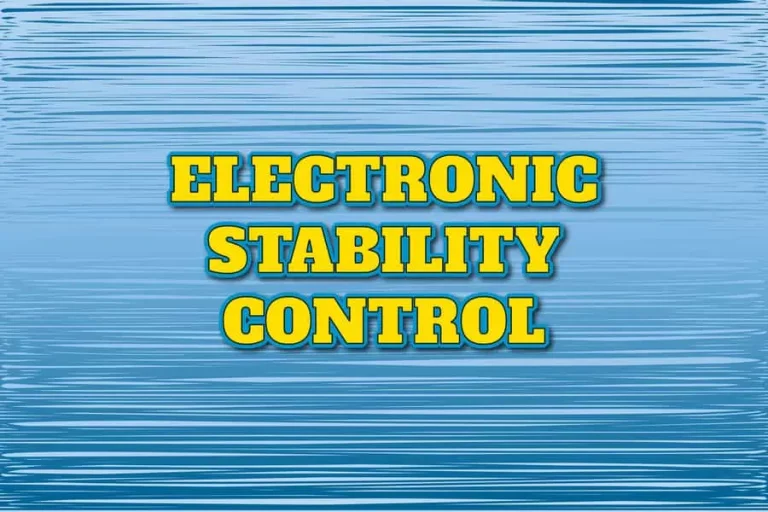If you’re hearing about ESC or electronic stability control for the first time, you’re not alone. Modern automobiles boast several features that improve safety and make driving enjoyable.
The ESC is one of such features, and in this post, we will discuss what it does and everything you need to know. We will also share the reasons the ESC light turns on and other related information. Keep reading to learn more about this topic.
What Is Electronic Stability Control?
The electronic stability control or ESC is a crucial safety system in modern automobiles. It is the prerequisite for other safety features found in automobiles, like driver assistance systems.
The way in which the ESC works is unique. It helps improve safety and make driving easy. This system analyzes the data pulled from the wheel speed sensors and others such as lateral acceleration sensor and steering angle sensor, including yaw rate, comparing them to the driver’s input and paying attention to the behavior of the vehicle.
So, the ESC ensures the vehicle doesn’t develop a critical state. But when it does, a vehicle with an active ESC would get the best response.
In other words, if the ESC detects an unstable state, such as a sudden change in direction, it would respond in milliseconds. The reaction normally involves getting the vehicle stabilized via wheel-specific brake intervention, including the engine torque adjustment.
Another unique thing about the electronic stability control is that it provides analog-controlled and infinitely variable valves used for minimal pedal vibration, including high dozed pressure buildup in the vehicle’s automatic braking system of Adaptive Cruise Control, bringing the car to a complete halt.
Here are two situations where the electronic stability control might intervene.
1: Oversteer:
The electronic stability control intervenes when a vehicle threatens to oversteer. The ESC’s reaction involves applying the brake on the car’s outer wheels.
In general, much of the brake force is on the front wheel. It happens where the wheel slip is around 50%. Furthermore, this produces a counter torque, which compensates for the yawing torque that leads to oversteer.
2: Understeer:
The electronic stability control can still become active when a vehicle understeers and is about to drift straight ahead in a curve.
In this case, the ESC applies the brake to the vehicle’s inside wheels, with the largest brake force applied to the rear wheel.
What The Electronic Stability Control Light Mean
If you discover the ESC light flashing on your dashboard, note that your vehicle’s electronic stability control system may have an issue. Note that this system operates with the car’s traction control system. Together, they help control a vehicle in dangerous situations.
It is important to mention that electronic stability control (ESC) and traction control aren’t the same. Here is one of the differences.
In vehicles that use ESC, the traction control system will always be part of the features. In other words, stability control will always incorporate traction control.
On the other hand, not all vehicles that boast traction control have stability control. Stability control also has far more features than traction control. It has features that help in situations like oversteer and understeer.
How The Electronic Stability Control System Operates
The safety features of modern cars have improved over the years as manufacturers seek to reduce accidents on the road. The ESC is one of such safety systems.
The electronic stability control system is a special highway safety feature designed for vehicles. It helps to prevent accidents like wheel spin on slippery roads, common after a downpour of rain.
The ESC deploys a computer-controlled braking process for each wheel and assists the driver in maintaining cruise control of each tire in dire driving situations. The ESC is automatically activated when the system detects a loss of steering control through the ABS sensor.
A Handy Tip: Dynamic stability control can adjust understeering and oversteering. It deploys the traction control system, adjusts the engine power to lower speed, and applies brakes so as to prevent a rollover from taking place.
What Causes The Electronic Stability Control Light To Turn On
Modern vehicles have various indicators that mean different things. The indicator or warning lights tell car owners that something isn’t right with their vehicle.
The ESC light is one of the indicators or warning lights that turn on when something isn’t right in a vehicle. And when it does, you must take steps to address the problem before it escalates or produces undesirable outcomes.
Below, we discussed the reasons your ESC light turns on so you can know where the problem is and take steps to address it for your car or truck to perform optimally.
1: Faulty steering angle sensor:
The steering angle sensor is one of the culprits when the ESC light turns on. The ESC light turns on when the steering angle sensor is out of alignment or totally damaged.
The steering angle sensor performs an important task in automobiles. It notifies the car computer about how far the wheels are turned and does so with massive speed.
Solution: A faulty or damaged steering angle sensor isn’t an issue an inexperienced individual can fix. It requires an expert. Your car needs a trouble specialist to check and fix the sensor. The light will turn off once the sensor is fixed.
2: Blown fuse/Battery problem:
The electronic stability control light you’re seeing could be a sign that your car battery is low. A blown fuse can be another reason the light turned on.
Solution: Electrical issues are very delicate and can make your vehicle challenging to drive on the highway. So, make plans to visit your mechanic to diagnose and fix the problem. The ESC light will turn off once the problem is addressed.
3: Wheel alignment problem:
Wheel misalignment can cause the ESC light to come on. Your wheels can become misaligned when the vehicle hits a curb or falls into a pothole. Another incident that can cause misalignment is when the car hits a speed bump at high speed.
It is easy to detect when a vehicle has misaligned wheels. You’ll notice the vehicle tilting to one side when driving. It will become hard to drive such a vehicle straight.
Solution: The ESC light will turn off when you align the wheels. So, take your vehicle to a professional for wheel alignment.
4: The ESC system switched off:
Most vehicles have an option where you can turn the ESC system off. But when you do, the light won’t go away. The ESC is an important safety feature in the vehicle. Thus, when you turn the system off, expect the light to come on.
A Handy Tip: Find out how to switch the ESC on and off. Sometimes, you can fix the problem by this simple gesture.
5: Faulty anti-lock brake:
Is your vehicle’s anti-lock brake malfunctioning? If yes, it could be the reason your ESC light is turned on. Several things can cause your anti-lock brake to malfunction. This includes worn-out brake pads, low brake fluid, or faulty sensors.
Solution: You need a professional to fix this problem, and the sooner you do so, the better.
Can You Drive A Vehicle With The Electronic Stability Control Light On?
You can drive your vehicle even when the ESC light is on, but this isn’t a good idea. The light is on because something isn’t right with the car. It could be the wheel or other important system in the car important to your safety.
So, the best thing is to find out why the light was on and fix the problem as quickly as possible. But if you find yourself driving and the light comes on, observe the following precautions while looking for a place to fix your car.
- To drive with too much speed. Slow down the car, park it somewhere, and contact your mechanic to fix the car.
- If you have been practicing safe driving habits, now is the time to practice it even more.
- It would be best if you avoided slippery roads at this point.
The Difference Between Electronic Stability Control And Traction Control System
The ESC and traction control system perform similar roles. Both ensure the individual wheels don’t lose friction, especially when riding on a slippery road and slipping.
The ESC program is a more advanced version of the traction control program. It boasts more powerful monitoring systems and tools.
A Handy Tip: While the traction control system limits wheel spin, electronic stability control can maneuver a vehicle.
Conclusion
The electronic stability control is an important safety feature in modern vehicles. It can detect when a vehicle is in an unstable state, such as a change in direction, and responds in milliseconds.
The ESC stabilizes the vehicle via wheel brake intervention and even engine torque adjustment. The ESC light also turns on as a signal that something isn’t right in a vehicle.
The reason the light turns on could be wheel misalignment, faulty steering angle sensor, low battery or blown fuse, or when the ESC system is turned off.
Finally, we explained that it is possible to drive a vehicle when the ESC light turns on. But make moves to fix the problem quickly, as your safety is at stake. In addition, avoid driving at top speed if the ESC is faulty.










